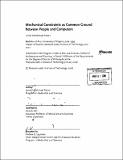| dc.contributor.advisor | Hiroshi Ishii. | en_US |
| dc.contributor.author | Patten, James McMichael, 1977- | en_US |
| dc.contributor.other | Massachusetts Institute of Technology. Dept. of Architecture. Program In Media Arts and Sciences | en_US |
| dc.date.accessioned | 2007-10-22T16:19:25Z | |
| dc.date.available | 2007-10-22T16:19:25Z | |
| dc.date.copyright | 2006 | en_US |
| dc.date.issued | 2006 | en_US |
| dc.identifier.uri | http://dspace.mit.edu/handle/1721.1/34179 | en_US |
| dc.identifier.uri | http://hdl.handle.net/1721.1/34179 | |
| dc.description | Thesis (Ph. D.)--Massachusetts Institute of Technology, School of Architecture and Planning, Program in Media Arts and Sciences, 2006. | en_US |
| dc.description | Includes bibliographical references (p. 143-149). | en_US |
| dc.description.abstract | This thesis presents a new type of human-computer interface based on mechanical constraints that combines some of the tactile feedback and affordances of mechanical systems with the abstract computational power of modern computers. The interface is based on a tabletop interaction surface that can sense and move small objects on top of it. Computation is merged with dynamic physical processes on the tabletop that are exposed to and modified by the user in order to accomplish his or her task. The system places mechanical constraints and mathematical constraints on the same level, allowing users to guide simulations and optimization processes by constraining the motion of physical objects on the interaction surface. The interface provides ample opportunities for improvisation by allowing the user to employ a rich variety of everyday physical objects as interface elements. Subjects in an evaluation were more effective at solving a complex spatial layout problem using this system than with either of two alternative interfaces that did not feature actuation. | en_US |
| dc.description.statementofresponsibility | James McMichael Patten. | en_US |
| dc.format.extent | 149 p. | en_US |
| dc.language.iso | eng | en_US |
| dc.publisher | Massachusetts Institute of Technology | en_US |
| dc.rights | M.I.T. theses are protected by copyright. They may be viewed from this source for any purpose, but reproduction or distribution in any format is prohibited without written permission. See provided URL for inquiries about permission. | en_US |
| dc.rights.uri | http://dspace.mit.edu/handle/1721.1/34179 | en_US |
| dc.rights.uri | http://dspace.mit.edu/handle/1721.1/7582 | |
| dc.subject | Architecture. Program In Media Arts and Sciences | en_US |
| dc.title | Mechanical constraints as common ground between people and computers | en_US |
| dc.type | Thesis | en_US |
| dc.description.degree | Ph.D. | en_US |
| dc.contributor.department | Program in Media Arts and Sciences (Massachusetts Institute of Technology) | |
| dc.identifier.oclc | 69410178 | en_US |
